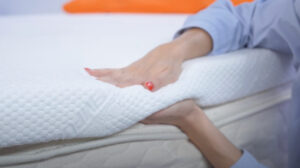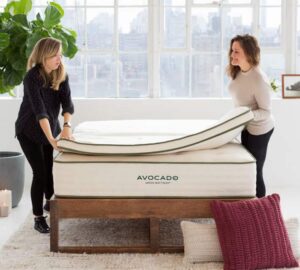Foam vs. Gel Mattress Toppers
Disclosure: By clicking on the product links in this article, Mattress Nerd may receive a commission fee at no cost to you, the reader. Read full disclosure statement.
A new mattress may not be in your budget anytime soon, but that doesn’t mean you have to resign yourself to uncomfortable nights. A mattress topper can be an excellent way to improve support and comfort without replacing your whole bed.
Like mattresses, there are lots of options when it comes to toppers. Here’s how foam and gel mattress toppers compare, and what to keep in mind as you shop.
What is a Mattress Topper?
Just as the name suggests, a mattress topper is a layer of memory foam, latex, or other material that is placed atop an existing mattress. It can serve several purposes, including changing the firmness level, adding support, improving comfort, relieving pressure, or helping you enjoy cooler sleep.
While mattress toppers likely aren’t a long-term fix for a really terrible mattress that lacks support, they can be a great addition to a mattress that’s just okay.
Don’t confuse mattress toppers with mattress protectors, which are generally used to shield a mattress from allergens, dust mites, spills, or general wear and tear.
Foam Mattress Toppers
| Pros | Cons |
| Provides pressure relief | Tends to trap heat |
| Isolates motion | |
| Wide range of options for support and comfort |
Memory foam is one of the most popular materials for mattress toppers because of its pressure-relieving properties. It’s a slow-moving material, which means you really sink into it when you lie down. That helps cushion your joints and contours around your hips, lower back, and shoulders for extra support. If you share your bed with a partner, memory foam can help minimize motion transfer so you don’t disturb one another at night.
On the downside, memory foam has a tendency to trap body heat. If you already sleep hot, memory foam will probably make that worse.
Polyfoam mattress toppers
Another type of foam, known as polyfoam, is used in many budget mattress toppers. It’s not as durable as memory foam, so you can’t expect the same lifespan, but it will add a level of comfort and pressure relief. Plus, it will cost less than a memory foam mattress topper.
Gel Mattress Toppers
| Pros | Cons |
| Provides temperature regulation | Can be more expensive than other options |
| Helps relieve pressure points | |
| Isolates motion |
Gel mattress toppers have a lot of the same benefits as memory foam, including pressure relief and motion isolation. That’s because they’re made with the same type of material, with one important difference. A gel mattress topper has a layer, or sometimes an infusion, of gel in the foam.
This material helps disperse body heat to keep you cooler and more comfortable while you sleep. The addition of gel also changes the feel of the topper slightly. In addition to feeling cooler, gel and gel-infused memory foam toppers are slightly more cushioning and pliant. Traditional memory foam toppers will feel firmer and a little more resilient.
While gel mattress toppers are well-suited to anyone who tends to overheat while they sleep, they are a pricier option than standard memory foam–and the difference can be significant. They also make the topper heavier, so that’s worth keeping in mind.
Popular Foam Mattress Toppers
Saatva Mattress Topper
Saatva offers three different types of mattress toppers. The foam topper is 1.5 inches of CertiPUR-US Certified, high-density foam. It’s an affordable pick designed to add comfort and support through even weight distribution and a medium firmness that accommodates all sleep positions.
TEMPUR Toppers
Tempurpedic is synonymous with memory foam, and this topper can be a budget-friendly way to enjoy the company’s proprietary TEMPUR material without splurging on an entire mattress. The two-inch topper is resistant to dust mites and allergens and comes with a removable and washable cover.
Popular Gel Mattress Toppers
DreamFoam Memory Foam Topper
The DreamFoam topper is made with two inches of soft, gel-swirled memory foam. The cooling gel helps dissipate body heat so you don’t get too hot at night. Because the material is slow to respond, it’s best suited to sleepers who don’t switch positions too often.
Layla Mattress Topper
This Layla memory foam mattress topper has a plush, cloud-like feel and measures two inches in height. It’s infused with copper and gel to keep you cool and comfortable. Plus, the cover has a cooling agent for a cool-to-the-touch feel.
Other Types of Mattress Toppers
Latex
Latex is another popular material for mattress toppers. This naturally-derived material is responsive, with a buoyant feel and deep pressure relief. It’s naturally temperature regulating, so it’s a great pick for hot sleepers. Latex is also a really durable material, which means a longer lifespan for your topper.
One downside to latex toppers is that they can be expensive. They’re also quite heavy, which can make changing the sheets a challenge.
Polyester
This synthetic material is used in mattress toppers that are designed only as a comfort layer. They’re inexpensive and add a soft, plush surface. Polyester is often used as a down alternative, so they have a similar airy feel.
Long-term durability can be an issue with polyester toppers, which tend to break down faster than those made with other materials.
Wool
Despite its reputation for being hot and itchy, wool can be an excellent material for a mattress topper. Wool is resistant to mold and mildew, naturally wicks away moisture, and regulates temperature to keep you comfortable. It’s a breathable material with impressive durability.
Like polyester, thought, an all-wool topper won’t add support. It’s a layer designed for temperature regulation and softness only.
Down
Down mattress toppers are also known as featherbeds. These toppers are made with a cotton shell stuffed with down. That makes for an incredibly soft, plush, warm sleep surface. Again, this won’t add support, but it’s a great choice for a softer, cozier bed.
It’s important to opt for down toppers that are humanely sourced, so look for certifications from the Responsible Down Standard or Downmark.
Foam vs. Gel Mattress Topper FAQs
What kind of bed topper is best?
Because mattress toppers come in a variety of options, there’s no single best topper. Individual preferences will play a big role in the right topper for your needs. If you love the sensation of sinking into your bed, for example, or you’re looking to alleviate pressure point pain, a memory foam topper might be the best option for you.
What is the difference between foam and gel mattress topper?
The main difference between foam and gel mattress toppers is temperature regulation. Both materials will offer a contouring feel and pressure relief, but traditional memory foam can trap body heat. Gel mattress toppers are designed to dissipate body heat for cooler sleep.
Is a memory foam or latex mattress topper better?
Memory foam and latex both have their benefits, so this will come down to personal preference. Memory foam had a cradling feel—sleepers really sink into the topper. Latex has a more buoyant feel, with the sensation that you’re on top of the topper and in it. Both materials relieve pressure and isolate motion well, but latex is also temperature neutral. That makes it a good pick for hot sleepers.
Takeaway
Mattress toppers come in all sorts of materials and options, and both foam and gel foam toppers can dramatically improve your sleep setup. These materials are a great way to add a comfortable, supportive layer to your current mattress, without breaking the bank. If you’re a hot sleeper, however, we’ll steer you toward gel foam toppers–they won’t retain body heat the way traditional memory foam toppers can.


